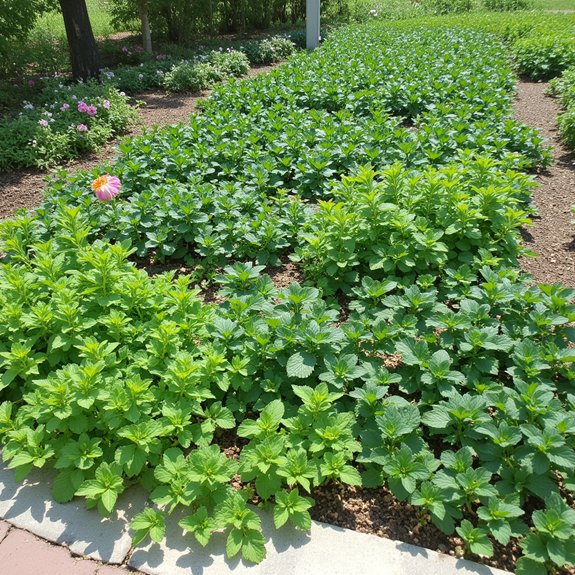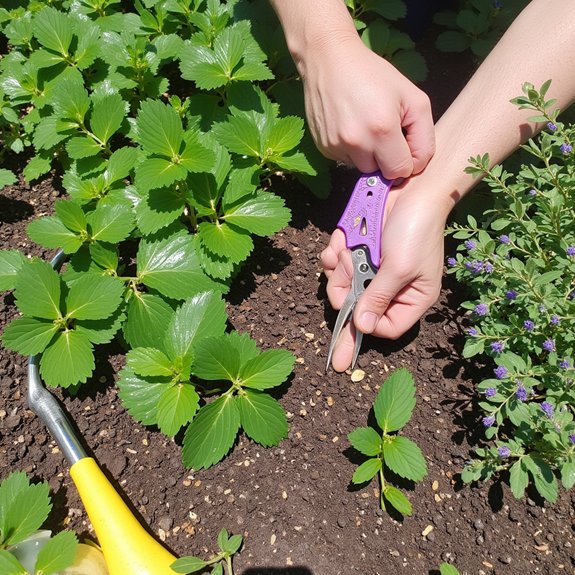Like Johnny Appleseed spreading prosperity across the frontier, gardeners can transform barren patches into productive landscapes using edible ground covers. These dual-purpose plants offer fresh herbs, berries, and vegetables while eliminating the need for traditional mulch or grass. Most varieties establish dense coverage within 6-12 months, requiring minimal water once rooted. However, selecting the wrong species for your specific conditions can lead to disappointing results, making proper plant choice absolutely critical for success.
Contents
Benefits of Edible Ground Cover Plants

While traditional landscaping focuses mainly on aesthetics, edible ground cover plants deliver multiple advantages that transform any yard into a productive space. These versatile plants provide fresh herbs, fruits, and vegetables right outside your door, reducing grocery bills while maximizing garden productivity. Many varieties offer excellent pest control benefits, like oregano repelling sap-sucking insects and nasturtiums attracting aphids away from vulnerable crops. The nutrient benefits extend beyond harvest, as these plants often improve soil health through natural processes. They’ll cover problem areas, prevent erosion, and create low-maintenance landscapes that work harder than ornamental alternatives.
Best Low-Growing Options for Dense Coverage
When creating a living carpet that hugs the ground, three standout options deliver exceptional coverage without competing for vertical space. Creeping thyme forms dense clumps that completely blanket soil, producing purple flowers while handling foot traffic remarkably well. Its aromatic leaves release pleasant scents when stepped on, making pathways both functional and fragrant.
Alpine strawberries create tight, runner-free mats that thrive in shadier spots where other plants struggle. These woodland varieties produce intensely sweet, small fruits while requiring minimal maintenance.
Corsican mint rounds out this trio, spreading into dense carpets with tiny rounded leaves, perfect for dappled light areas.
Rapid-Spreading Varieties for Large Areas

Four vigorous spreaders can transform bare expanses into productive food sources faster than traditional ground covers. Pumpkin varieties lead this category, with vines extending 10-20 feet in full sun conditions. These heavy feeders need rich soil and consistent watering but reward gardeners with impressive coverage rates.
Sweet potato vines offer dual benefits, producing edible tubers while their nutritious leaves create dense mats. Meanwhile, cucamelon growth delivers unique grape-sized fruits on sprawling vines that double as climbing plants when supported.
Nasturtiums complete this powerhouse group, establishing full coverage within 6-8 weeks from seed while attracting beneficial insects.
Shade-Tolerant Edible Ground Covers
Since shaded areas often challenge gardeners seeking productive ground covers, several edible options thrive in low-light conditions where traditional crops fail. Alpine strawberries excel beneath tree canopies, producing sweet fruits without requiring full sun exposure. These woodland varieties tolerate dappled light while creating dense coverage.
Corsican mint forms thick carpets under trees, offering tiny aromatic leaves perfect for teas. French sorrel adapts well to partial shade, spreading quickly with shield-like foliage. These shade loving herbs work excellently in companion planting schemes, filling gaps where sun-hungry vegetables can’t establish. Dandelions naturally colonize shaded spots, providing completely edible plants.
Maintenance and Care Requirements

Most edible ground covers require surprisingly little maintenance once they’re established, though each plant’s needs vary considerably during the first growing season. Watering remains essential during the first six weeks, with most plants needing one inch weekly.
Fertilizer application depends on soil conditions and plant type. Heavy feeders like pumpkins benefit from monthly feeding, while herbs like thyme thrive without supplements. Pest management stays minimal for most varieties, though nasturtiums actually attract beneficial insects while deterring harmful ones. Regular harvesting encourages continued growth and prevents overcrowding in established beds.
Planning Your Edible Landscape Design
When planning an edible landscape design, gardeners must first assess their yard’s unique conditions and available space before selecting the right ground cover combinations. Consider sun exposure, soil drainage, and foot traffic patterns when mapping out plant placement.
Effective planting strategies involve grouping plants with similar water and light requirements together. Place taller options like sweet potato vines in back borders, while positioning low-growing creeping thyme along pathways.
Design aesthetics matter too—combine colorful nasturtium flowers with green oregano foliage for visual interest. Space plants 12-18 inches apart for proper coverage within one growing season.
